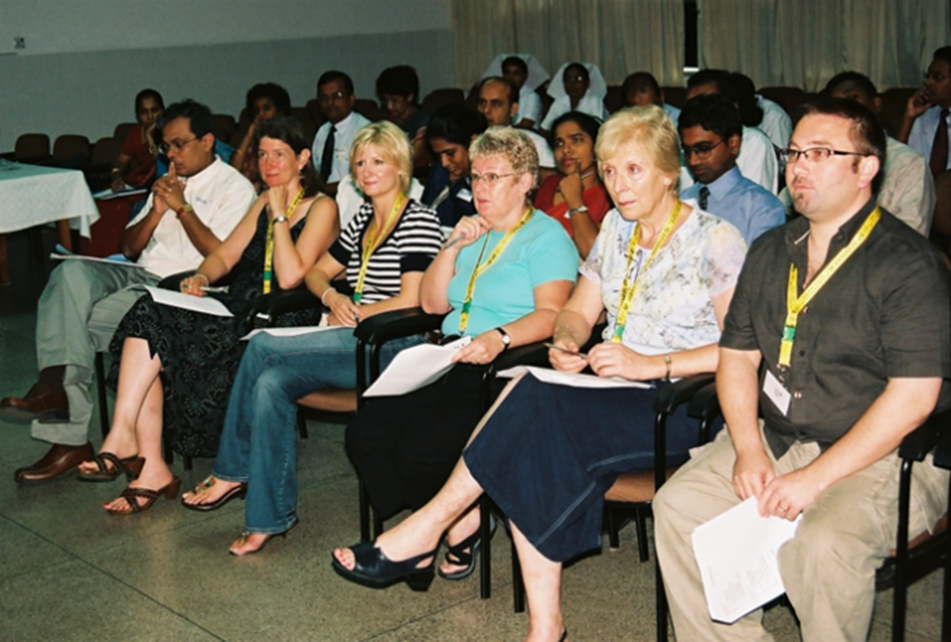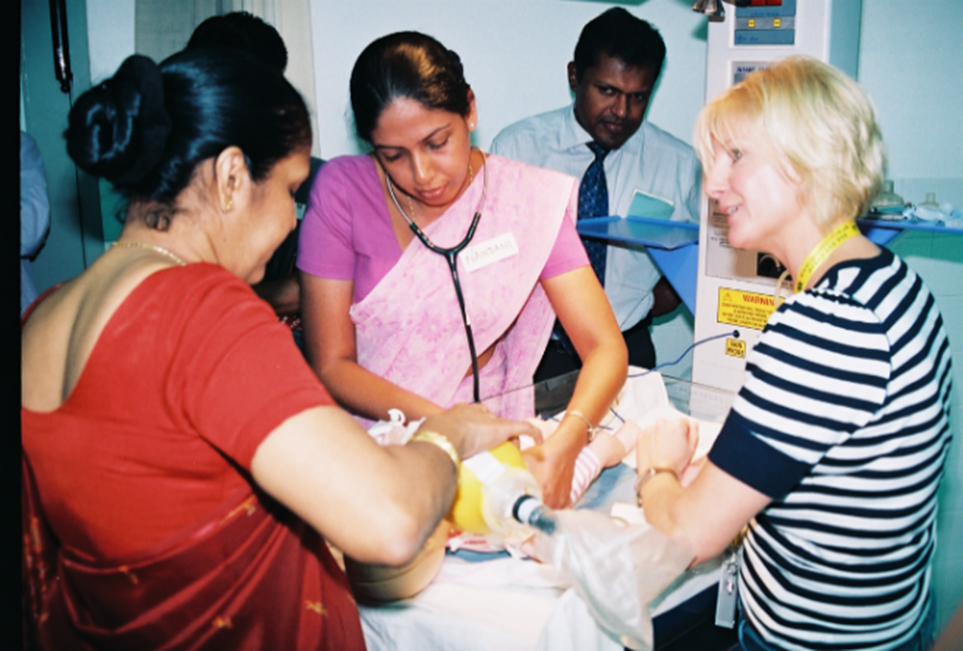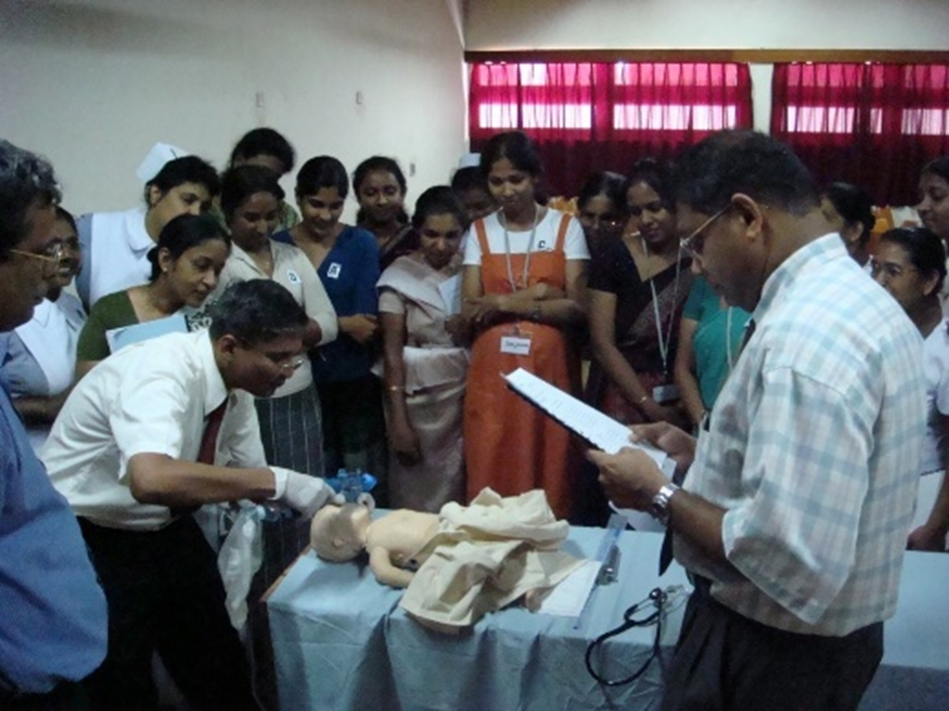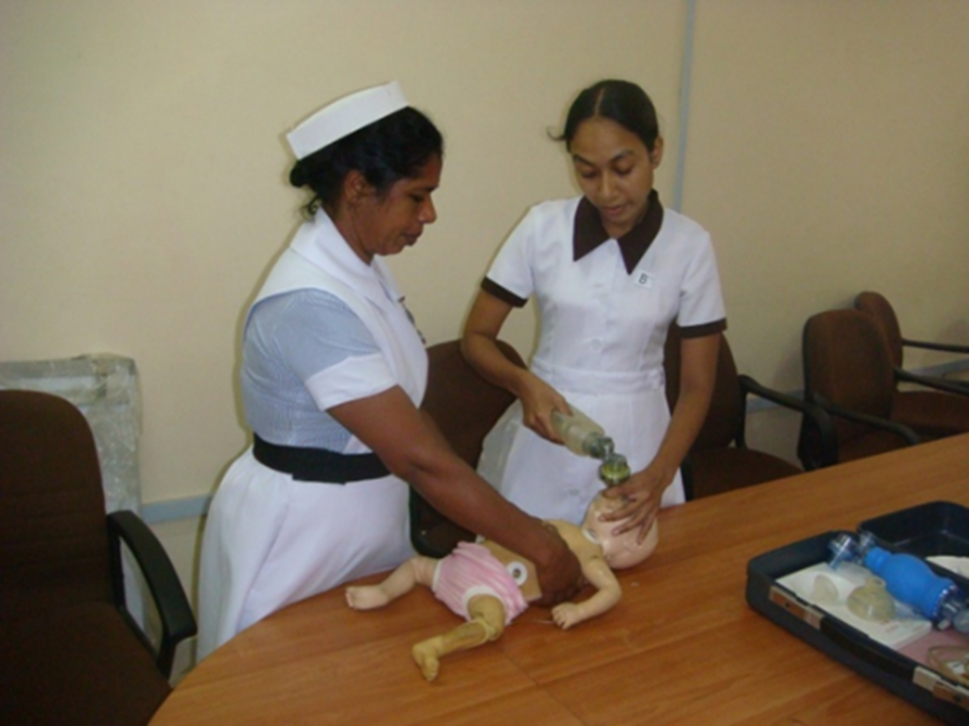NLS Course Structure
Neonatal Life Support course is a one-day course conducted by Sri Lanka College of Paediatricians. The Course is held at the Lady Ridgeway Hospital for Children as wells as in the provincial centers. The College of Paediatricians has appointed regional coordinators to ensure the uniformity of the course structure. The candidates are registered in the home page of the NLS / SLCP web site in order to receive the pre-course materials. The course consists of lectures, skills stations and scenarios. At the end of the course candidate will be assessed on airway skills and MCQ paper. Successful candidates will be issued a certificate which is valid for a period of 2 years.
Pre-course Preparation
The course manual can be downloaded from this web site. Hardcopy of the manual could be obtained from the SLCP office. It is mandatory that candidates should read the manual and submit online MCQ paper before they attend the course. Doctors, nurses, and midwives are undergoing the same NLS format, but level of assessment is subjected to differ.
Pre-Course Materials
Hard copy of the manual can be collected from the SLCP Office.
NLS course contents consists of three lectures (Physiology of newborn resuscitation, Resuscitation at birth, Pre-term delivery) and three skills Stations (Airway Management, Chest compressions, Vascular access).
How to Register
How to Pay “Registration Fee”
Account Number – 0077318402
Account Name – Sri Lanka College of Paediatricians, Skills Development.
Account containing branch – BOC Borella Branch
If you pay to a bank please keep the bank slip with you. It is mandatory to provide it at the programme day.
Cancellation Policy
If you are unable to attend, you will have to pay an extra Rs 500.00 with your confirmation in the future courses.
Accommodation Details
Accommodation is not included in the registration fee and should be paid by you separately.
Parking Space
A Public Car Park is available on the Baseline Road in front of the Welikada Prison.
History of NLS
Background and Justification for the Intervention
Globally, birth asphyxia accounts for around 30% of the neonatal deaths. In Sri Lanka, out of the total neonatal mortality, 11% of deaths are due to birth asphyxia. Lifetime morbidity in the form of persistent disabilities resulting from birth asphyxia too is quite significant. There are only very few multi-disciplinary centres and very few professionals to cater to the needs of children who are physically and mentally disabled in the aftermath of neonatal asphyxia. These children have an insecure future in a developing country like ours, due to financial constraints and minimal rehabilitation facilities.
However, it must be very clearly stated that the fact of the matter is that there are effective and inexpensive ways to prevent these consequences of asphyxia that have remained unexplored in the health system of many developing countries. One such cost-effective preventive strategy is education and training of healthcare professionals on Neonatal Life Support to try and minimise the incidence and the consequences of birth asphyxia as well as manage it, if and when it occurs despite all our efforts towards prevention. This is the best way to curtail mortality and morbidity associated with asphyxiated births.
New-born Life Support (NLS) Courses have been developed in most of the developed countries as well as some of the developing countries to impart new and evidence-based knowledge and skills of neonatal resuscitation. The NLS in the United Kingdom (UK) has been developed under the auspices of The Resuscitation Council of the UK to provide clear practical instructions in airway support and theoretical backgrounds to illustrate its importance in resuscitation of the new-born.
Key events and documents related to the initiation of Neonatal Life Support (NLS) Programmes in Sri Lanka
In 1991, the Postgraduate Institute of Medicine (PGIM) of the University of Colombo organised a two-day workshop on Neonatal resuscitation, with the help of Dr Kumararatne from USA. The Postgraduate Trainees in Paediatrics were exposed to a well-structured Training Programme to get hands-on-training using manikins. This was confined to the Postgraduate Trainees and did not involve other doctors and the other grades of staff. Unfortunately, there were no follow-up workshops after that.
The Sri Lanka Paediatric Association, in partnership with the Sri Lanka College of Obstetricians and Gynaecologists, and the Ministry of Health, organised a workshop in Colombo on neonatal resuscitation in 1995. This event was organised in collaboration with the Division of Neonatology, Department of Paediatrics, All India Institute of Medical Sciences, New Delhi, India. It was held on 29th January 1995 and it consisted of a hands-on training venture.
The purpose of this workshop was to ‘Train the Trainers’, who would go back to their own institutions and train other healthcare workers in proper neonatal resuscitation techniques. The resource personnel for the workshop were Professor Meharban Singh(former Professor of Paediatrics & Neonatology), Dr. Vinod K Paul(Professor of Paediatrics) and Dr. Ashok K Deorari(Professor of Neonatology), all from All India Institute of Medicine(AIIMS), New Delhi India. The main sponsor for this workshop was UNICEF, which was represented coordinated by Dr. Hiranthi Wijemanne. The electronic manikins for training were brought by the team from the All-India Institute of Medical Sciences.
It was a very successful workshop and many paediatricians from right round the country attended the event. The general concept was for these trainers who were trained to train all doctors, nurses and mid-wives in their region on neonatal resuscitation. However, we did not have the essential manikins to train the healthcare workers and whatever training that would be undertaken would really be only a theoretical exercise. These manikins were quite expensive.
The Sri Lanka Paediatric Association (SLPA), which had been in existence since 1952, was smoothly transformed to the Sri Lanka College of Paediatricians (SLCP) in the second quarter of 1996. An important and most significant event took place in the very first year of the newly inaugurated Sri Lanka College of Paediatricians.
Virtually soon after his induction, the first President of the College, Dr. B. J. C. Perera, wrote a letter to the newspapers of Sri Lanka, explaining the need for intensive training of doctors, nurses and midwives on resuscitation of asphyxiated newly born babies. He extolled the virtues of bag and mask ventilation and reiterated that the vast majority of asphyxiated babies could be successfully resuscitated by bag and mask ventilation without any danger of long-term undesirable consequences. In that beautifully written emotive letter, he appealed to the general public to contribute to a fund to buy training manikins for the SLCP.
The letter was published just once in several newspapers. There was a concerted and magnificent response from the general public. Very many members of them promptly made donations to the SLCP and the total amount required to purchase the manikins, amounting to a couple of lakhs of rupees, was collected within just a couple of weeks. Then two state-of-the-art electronic training manikins, one for bag and mask ventilation as well as cardiac compressions and the other for endotracheal intubation, were purchased from Bio Med International (Pvt) Limited, at considerable cost. The entire endeavour was totally funded by the general public.
Then the training programmes on neonatal resuscitation were started. The Sri Lanka College of Paediatricians conducted these workshops in Colombo as well as many areas of the rest of the country with the help of local paediatricians. To achieve the goals of these ‘hands-on’ training, a Handbook of Neonatal Resuscitation had been previously published by Dr. G. N. Lucas and Dr. B. J. C. Perera, on 23rd September 1995. A Sinhala translation was also done with the help of Miss M. Nishani Lucas, the school-girl daughter of Dr. Lucas. The booklet was printed by UNICEF. This same Miss Nishani Lucas is now a Consultant Neonatologist at the De Soysa Maternity Hospital in Colombo and is intimately involved in the Neonatal Life Support Training Programmes.
Using the manikins and booklets, workshops were conducted all over Sri Lanka. Many doctors, nurses and midwives from right round the island were trained in neonatal resuscitation. The Consultant Paediatricians working right round the country helped a great deal to facilitate and take part in these ventures. Following these programmes, there was a general feeling that the incidence of deaths and long-term neurological consequences following asphyxia of the new-borns were very significantly reduced.
Years later the Sri Lanka College of Paediatricians realised that even though equipment was available, a more extensive and sustainable programme was necessary. All the delivery room staff was not quite competent to use the necessary equipment effectively. There was some lack of knowledge in principles of basic resuscitation. Most of the time doctors and nurses followed the seniors blindly without much knowledge of the underlying patho-physiology of new-borns.
Master Training Course in 2006
Evolution of Neonatal Life Support Programme in Sri Lanka.
Master Training of Neonatal Life Support
In 2006 Dr Babu Kumararatne, Consultant Neonatologist in Wolverhampton Hospital in the UK, offered to help us. Being a Sri Lankan and having understood the scenario in Sri Lanka, he liaised with the Resuscitation Council of UK and the Perinatal Society of Sri Lanka to establish the NLS module in Sri Lanka. The project proposal was written by Dr Guwani Liyanage, then senior register in Paediatrics. In September 2006, the NLS Provider Course was held for the first time in Sri Lanka. Dr Aberra Bekele, Head of the Childhood Programme of UNICEF took a keen interest in this project which was sponsored by the UNICEF. Dr Anoma Jayathilake, the Programme Coordinator for Maternal and New-born Programme in the Family Health Bureau (FHB), liaised with UNICEF. Dr Srilal de Silva liaised with Dr Babu Kumararatne and UNICEF office for effective implementation of the programme. The logistics were coordinated by Dr Srilal de Silva through the Perinatal Society of Sri Lanka.
The resource persons were from the Resuscitation Council of UK. Total of 80 participants were trained which included 65 consultant paediatricians. Four master trainer courses were held back-to-back from 10th to 14th September 2006 at Lady Ridgeway Hospital, Colombo. The objective was to provide clear instructions of resuscitation of babies at birth for doctors who were involved in neonatal resuscitation. This course provided background knowledge and skills for the management of new-born infants for the first 10-20 minutes in a competent manner. It concentrated on the effective teaching of practical airway management and ventilator support.
In 2006, after the initiation of the Master Training Programme, the Resuscitation Council of UK, selected a few candidates to be trained as Generic Instructors. Unfortunately, Instructor Course did not materialize due to lack of funds. However, most of the instructors were able to get the Generic Instructor Training held in Sri Lanka by the APLS Faculty of Australia latter on.


Local NLS Courses
Following the Master Training Programme, it was Dr Abeera Bekle from UNIECF, who persuaded Dr Srilal De silva to scale up the programmes to all the rest of the new-born care givers. Dr Sapumal Danapala who represented UNICEF provided equipment for the programme, a lap-top computer, and a photocopy machine. These equipment were placed at the Medical Intensive Care Unit at the Lady Ridgeway Hospital, where Dr Srilal de Silva was the consultant in charge.
The programme was initially started at the Lady Ridgeway Hospital in Colombo by Dr Srilal de Silva. Although none of the team had undergone Generic Teaching Skills Course, they managed to conduct a satisfactory programme. The targets were achieved. These courses were facilitated under the patronage of the Sri Lanka College of Paediatricians and the Perinatal Society of Sri Lanka. While some of the courses were paid courses, most were financed by the Ministry of Health, both from central government and provincial health ministry budgets. All these programmes were coordinated by the office located at the Medical intensive Care Unit of the Lady Ridgeway Hospital. Since the programme was a success, there was a growing demand for subsequent programmes.
Prof Chandra Abeysekara, of the University Paediatric Unit, Peradeniya became the President of Sri Lanka College of Paediatricians in year 2008/2009. Her theme was to “promote distant education”. Her target was to conduct two days continuous professional development programmes in each province during her tenure. The first day of the programme was to introduce the guidelines prepared by the Sri Lanka College of Paediatricians under the Health Sector Development programme. The Neonatal Life Support module was conducted on day two. These programmes were funded by the Pharmaceutical Industry. The first programme was conducted in the Uva Province. During her tenure as the College President, Professor Abeysekera was able to conduct this module in all the provinces except in the East. This last one had to be cancelled at the last minute due to the terrorist activities that were prevalent in that area. Enthusiastic members of the Sri Lanka College of Paediatricians voluntarily travelled throughout the country, imparting knowledge and skills to healthcare workers who otherwise would have continued in their traditional practices.
Development of Training Materials and the Curriculum
Local Manual
Following the Master Training Programmes, a local manual was written under the Health sector Development Project of SLCP. This was based on the 2nd edition of Neonatal Resuscitation Manual of the Resuscitation Council of the UK and was formulated by Dr. Srilal de Silva, Dr. P. M. Wijewardana, Dr. Chandani Wickramsinghe and Dr. Sandya Bandara. The first ever local programme was commenced on 27th July 2007. In 2008 the Training Manual was translated to the local languages (Sinhalese and Tamil version). English manual was updated periodically by the local faculty in keeping with the updated International Resuscitation Council Guidelines by Dr. Priyantha Perera in 2012, Dr. Ranmali Rodrigo in 2014. Dr. Nandanee Wickramasingha and Dr B. J. C. Perera edited the manual. In 2015 the updated manual was translated to Sinhala and Tamil. The latest edition came out in 2019.
Ministry Circular for duty Leave
A circular for duty leave for the resource persons conducting Neonatal Life Support Programmes was issued by Ministry of Healthcare and Nutrition under the Reference Number of PSSL/09/01 dated 12 August 2009. Duty leave for the participants are approved by the Deputy Director General / Education, Training and Research of the Ministry of Health (DDG ET&R) or Provincial Director’s Office of Health Services when the participants are identified.
Manikins
Ministry of Health allocated funds to procure manikins for Neonatal life Support through the Family Health Bureau. These manikins were distributed by the Family Health Bureau to all major hospitals in the provinces to carry out Neonatal resuscitation programmes.
Equipment used for the course
- 6 Neonatal manikins with bag & mask
- 4 manikins for training on airway intubation
- 6 self-inflating bags (450ml and 250ml)
- 6 bottles to practice Umbilical Venous access
- 6 Yankuar suckers
- 6 face masks of all three sizes
- 6 sets of oral airways.
The Current NLS Programme
Leadership and governance from the Ministry to in cooperate into National Health guidelines &Health financing.
Health-Sector Development Project of the Ministry of Health
NLS modules and National Guidelines were prepared by the Sri Lanka College of Paediatricians under the Health Sector Development Project under the Ministry of Health in 2012. The full programme is almost similar to the NLS Programme conducted in the UK. NLS Programme is a one-day programme.
Participants were sent by the Consultants in the units where neonatal resuscitation takes place. Target participants have been doctors, nurses and midwives who are first responders for the new-born. Candidates are given the manual and a Pre-Course MCQ as pre-course materials. This allows them to go through the manual and understand the concepts in resuscitation and answer the Pre-Course MCQ. On the day of the course the candidates hand over the Pre-Course MCQ to the coordinator.
Eight Consultant Paediatricians / Neonatologists and Senior medical officers were required for each course as resource personnel. There are three main lectures (Physiology, Resuscitation and Special Cases), three workstations (airway management, external chest compressions, vascular access). Lectures and Skills Teaching were done according to the Basic Generic Instructor teaching principles.
This is followed by a demonstration scenario and teaching scenarios. A simple uncomplicated scenario was demonstrated by the Faculty Members, stressing the key learning points in the scenario. At the end of the demonstration scenario a debriefing session was conducted. Participants were given an opportunity to clarify any doubts (debriefing).
Following this the candidates are given a chance to practise teaching scenarios which are conducted by Faculty Members. Each candidate gets one practising scenario and rest of the group have a chance to contribute to the scenario. The objective is to get confidence in handling different neonatal emergencies at birth. Scenarios range from simple uncomplicated scenarios to more complex situations. Scenarios include a term baby failing to breathe effectively, Pre-term delivery, baby born with meconium aspiration, a term baby who failed to start breathing due to maternal pethidine, a baby delivered in the ambulance, a baby delivered with undetected congenital diaphragmatic hernia, a baby who needed adrenaline either through umbilical venous cannulation or one who needed endotracheal intubation. All these scenarios candidates were tested on their basic knowledge, skills and soft skills (non-technical skills).
Final component is the Skills Testing Session which include airway testing and Post-Course MCQ Test. At the beginning, it was only true / false questions, but single best response questions were included by Dr Ranmali Rodrigo in 2013. The scenarios and MCQ paper were regularly updated by Dr Srilal de Silva and Dr Ranmali Rodrigo.
Those who have scored more than 80% of the total marks in the Post-Course MCQ were given the certificate which is valid for 2 years. Feedback forms were collected at the end of the session.
Suitable candidates who demonstrated knowledge, understanding, skills, and the enthusiasm in areas of practice, teamwork, support and communication would be chosen to be trained as potential instructors.


Later the NLS Programmes were commenced in Karapitiya/Galle by Prof Sujeewa Amarasena and in Peradeniya by Dr Sandya Bandara and Dr Chandani Wickramasinghe. This catalysed the enthusiasm among peripheral paediatricians to train their own staff with the help of the already established NLS Faculty of the Sri Lanka College of Paediatricians. Dr Srilal De silva and Dr Akbar, Medical Officer from the Medical Intensive Care Unit coordinated all these activities on behalf of the SLCP. Manuals and Pre-Course MCQs were sent from the Medical Intensive Care Unit Office at LRH. Funding came from Training Budgets of Provincial Directors in the different provinces. A number of programmes were conducted in Southern, Central, Uva, Eastern, North and North-Central Provinces. Manikins and other equipment were packed into big container boxes and transported in hired vehicles to those places.
During the tenure of Prof Sujeewa Amarasena as the President of the Sri Lanka College of Paediatricians in 2014/2015, two important projects were initiated. First project was the setting up of nine Provincial Centres for skills development and training and the second project was the commencement of the Pre-Intern Training Programmes.
Ministry of Health, at the request of the Prof Sujeewa Amarasena, President SLCP, released Rs 5,000,000.00 to procure manikins for paediatric training. Family Health Bureau was requested to deliver the Neonatal Manikins to these provinces.
The second project was the commencement of the Pre-Intern Training Programme in 2015. All the pre-interns were given a chance to undergo two days of the two modules before the commencement of their internship. One module was the Neonatal Life Support Module and the other was the Paediatric Emergency Module. One day module on Paediatric Emergencies based on the Advanced Paediatric Life Support was prepared which included a few lectures, skills stations and scenarios. For each Provincial Training Centre, one of the local paediatricians / Neonatologist was appointed as the Course Director.
All the logistical work was handled by the Education & Training Division of the Sri Lanka College of Paediatiricans. The standard NLS manual and Standard Treatment Protocols and rest of the teaching formats were provided to all Course Directors. Local Paediatricians were the resource persons for these workshops. Since then, each year all the pre-interns were given a chance to complete these two modules before their internship.
Funding
Many provincial courses were funded by the Provincial Director’s Office where it was funded by UNICEF, World Bank, WHO, as an out of pocket expenditure. Medical Officer in Charge of Maternal and Child Health and the Medical Officer Planning of the Provincial Director’s Office took a leading role in organizing the workshops in the periphery.
Funding for Pre-Intern Programmes
Funds for the workshops came from Ministry Accident & Emergency Policy budget and from the budget of the Director ET & R.
Feedback
Feedback was obtained from the participants at the end of each course. Following are some of the remarks made by them.
- Everybody felt that the workshop lived up to their expectations having learnt the scientific basis of resuscitation.
- Almost all appreciated that they learnt the correct methods of new-born resuscitation and developed confidence in resuscitation skills.
- It helped to build up team dynamics (doctors, nurses and midwives).
- Nurses and Midwives understood that many simple interventions can be done until the arrival of the doctor.
- Intubation is not always necessary for successful resuscitation.
- All those who are involved (Doctors, Nurses and Midwives) with resuscitation should be given an opportunity to undergo the training.
- This should be made mandatory before starting neonatal appointment in Paediatrics, for the Obstetric Staff and the Undergraduate Curriculum.
- Totally new experience and learnt relatively simple practical skills of resuscitation.
- The most enjoyable course that they had ever attended, since they left the nursing school and medical school.
Impact of the Training Programmes
Up to now the NLS training was taught to significant proportions of first responders. These first responders are doctors, nurses and midwives. The knowledge gained by the participants was imparted to colleagues and juniors by informal teaching at their own working places. E.g. labour room and baby units. The data collected from Special Care Baby Unit Registers reveal the significant reduction of birth asphyxia morbidity and mortality over the years. Postgraduate Paediatric Trainees, who have successfully completed the programme in the United Kingdom, were selected to undergo NLS instructor training. Shorter version of the module with emphasis on a practical approach is being incorporated into Undergraduate Curriculum in their final year by Paediatric departments from respective Medical Faculties. All Government Nursing training schools needs to take this as module in their curriculum.
